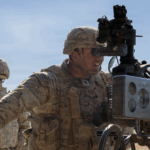
Army Chief of Staff Gen. Mark Milley has long favored giving the service chiefs an “intimate” role in acquisition programs and plans to lay that opinion out for the Senate Armed Services Committee (SASC) next week.Milley will be joined Jan. 25 by Chief of Naval Operations Adm. John Richardson, Marine Commandant Gen. Robert Neller and Air Force Chief of Staff Gen. Mark Welsh in testifying before SASC on the role of the service chiefs in acquisition.Service chiefs ought to have…

 By
By 











